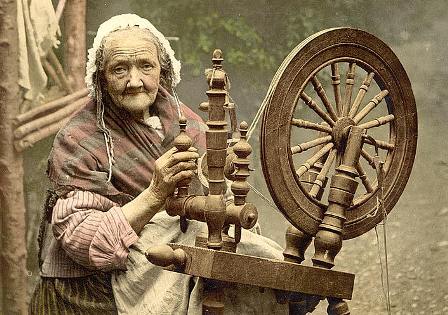
A couple of months ago I’ve decided it was time. Time to make an effort and try resurrecting the skills I was taught as a 4 year old by my grand-mothers. More precisely, I decided to give the mother of all home textile crafts another try: Knitting.
The nice thing about knitting is that, together with crochet, it requires only a very low up front investment – knitting needles may cost as little as a few £ or $ – but the possibilities are endless.
This said, 2 scarves later, and in the midst of an ongoing battle with my first ever knitted hat, I have memorised yet another lesson: Nothing comes easy, and as every skill, making, creating something to a satisfactory standard requires an arbitrary amount of time, patiences, determination, and – last but certainly not least – practice.
It’s not so long ago, though, that knowing how to make your own, be it knitted jumper, woven cloth for bed linen and curtains, or sewn dress, was an inseparable part of everyday life, and a precondition of marriage for the female half of the population. Not for nothing an old German saying points out the hardship of those who had no other option than to try and make a living off such a basic, domestic skill:
"Spinning in the morning brings hunger and worries. Spinning at night refreshes and revitalises." (Original: Spinnen am Morgen bringt Hunger und Sorgen; Spinnen am Abend erquickt und erlabend.)
The reality was that in those days, one could only ill afford not to possess the skill of knitting, spinning, embroidery, sewing, weaving etc. But only a selected few – the rich and better off – could afford to enjoy them at leisure :
"Indeed, what is perceived in awe today as the 'intensive labour' required to produce [...] fabrics was simply the minimal effort applied in earlier eras; far higher standards prevailed to measure the finest quality of such fabrics [...] which required an almost unimaginable - and certainly today unaffordable - patience." (Source: Beyond the Tanabata Bridge: Traditional Japanese Textiles, p. 37)
I, of course, given the times I live in, could just let it be, and choose to buy instead of making it myself.
Globalisation and modern industrial inventions allow me to eye-ball and judge the value of a garment – despite my rather abundant lack of textile craft skill, and therefore knowledge of how to truly differentiate between a good quality product and one less so. Much of the judgment, of course, is not influenced by how much effort actually went into the making of the garment itself, but rather, by the content of my wallet and my willingness to spend it (or not).
I am, after all, a child of my time.
So, struggling with my knitting I was, when the big IT struck me:
The lack of skill and ability to make our own, leaves us with a complete wrong understanding of what quality – not only clothing-wise – truly means. It has led us to live with a degree of conformity of which the global scale is hard to grasp. And, at the same time we end up underestimating, undervaluing, the amount of effort that goes into the process of making that what covers our nudity.
Because despite industrialisation, there remains a lot of hands-on work in the clothes making process.

‘How, if there are all those machines [spinning machines, power looms, sewing machines etc.]?’ you may ask.
Let’s take a simply example – accidentally knitwear. Have a look at the rough outline of the production process (right), and reflect on what each process step really encompasses.
Surprisingly, there is a lot of manual labour involved. Be it when moving the goods physically from one process step to the next, when working and controlling the power looms or knitting machines, orchestrating the dye vats, or when sewing pre-cut fabrics pieces up to form a finished garment. It’s all hands-on work. Iit’s the 21st Century, no doubt, but there remains a lot of hands-on experience and skills in the process of making clothes (or anything else, for that matter).
Today is Christmas day – let’s have some fun and come up with some new Christmas tree decorations ourselves – when, if not today, will we take the time again?

